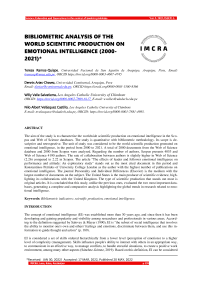Bibliometric analysis of the world scientific production on emotional intelligence (2000–2021)
Автор: Teresa Ramos-Quispe, Dennis Arias-Chavez, Willy Valle Salvatierra, Nilo Albert Velásquez Castillo
Журнал: Science, Education and Innovations in the Context of Modern Problems @imcra
Статья в выпуске: 3 vol.5, 2022 года.
Бесплатный доступ
The aim of the study is to characterize the worldwide scientific production on emotional intelligence in the Sco-pus and Web of Science databases. The study is quantitative with bibliometric methodology. Its scope is de-scriptive and retrospective. The unit of study was considered to be the world scientific production generated on emotional intelligence, in the period from 2000 to 2021. A total of 2000 documents from the Web of Science database and 2000 from Scopus were analyzed. Regarding the number of authors, Scopus presents 4053 and Web of Science 4190 authors. The rate of collaboration between authors is slightly higher in Web of Science (2.26) compared to 2.22 in Scopus. The article "The effects of leader and follower emotional intelligence on performance and attitude: An exploratory study" stands out as the most cited document in this period and Konstantinos Petrides of University College London as the author with the highest number of publications on emotional intelligence. The journal Personality and Individual Differences (Elsevier) is the medium with the largest number of documents on the subject. The United States is the main producer of scientific evidence, high-lighting its collaborations with the United Kingdom. The type of scientific production that stands out most is original articles. It is concluded that this study, unlike the previous ones, evaluated the two most important data-bases, generating a complete and comparative analysis highlighting the global trends in research related to emo-tional intelligence.
Bibliometric indicators, scientific production, emotional intelligence
Короткий адрес: https://sciup.org/16010190
IDR: 16010190 | DOI: 10.56334/sei/5.3.20


